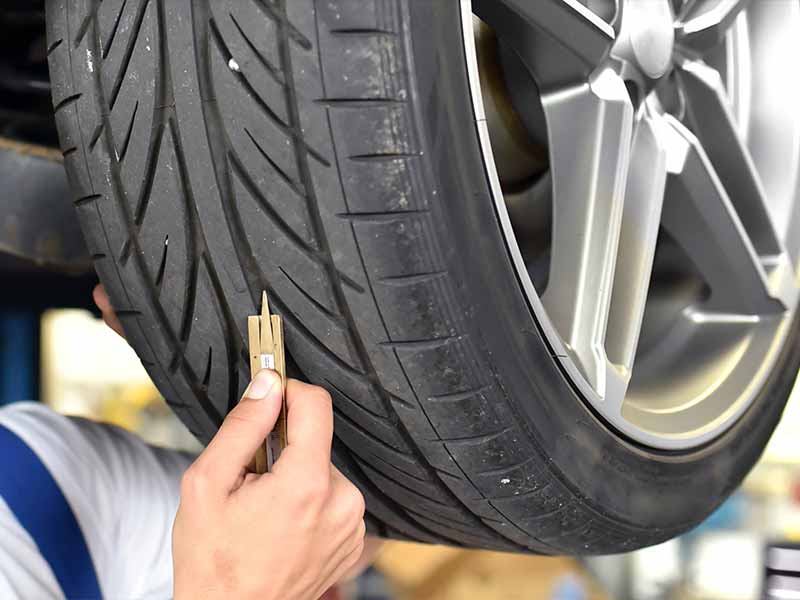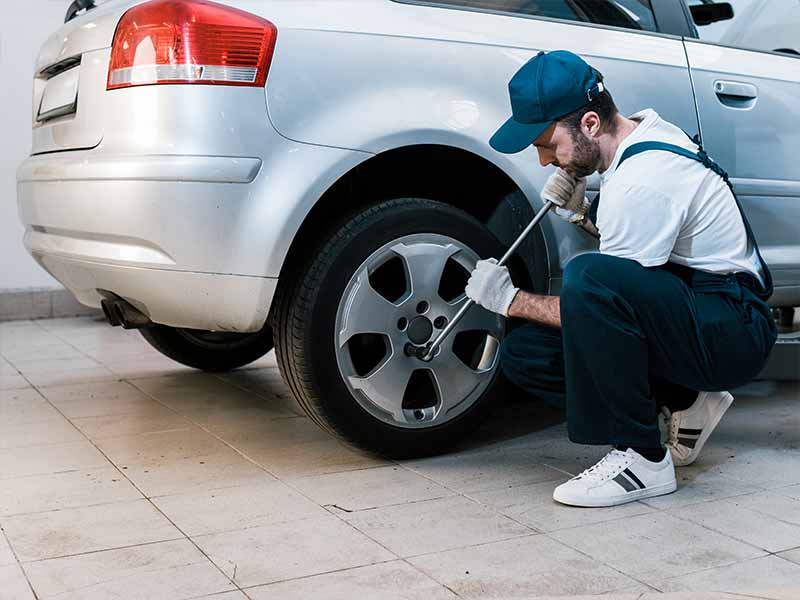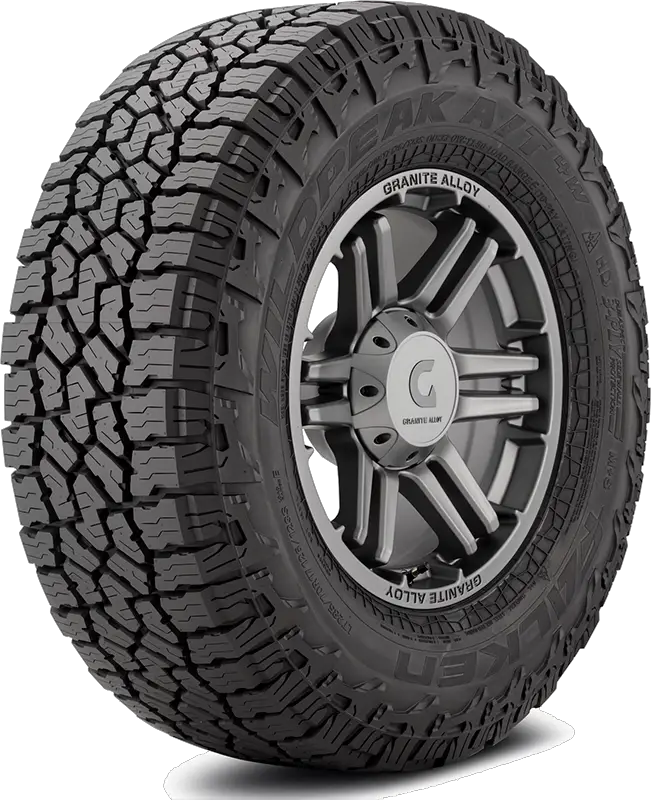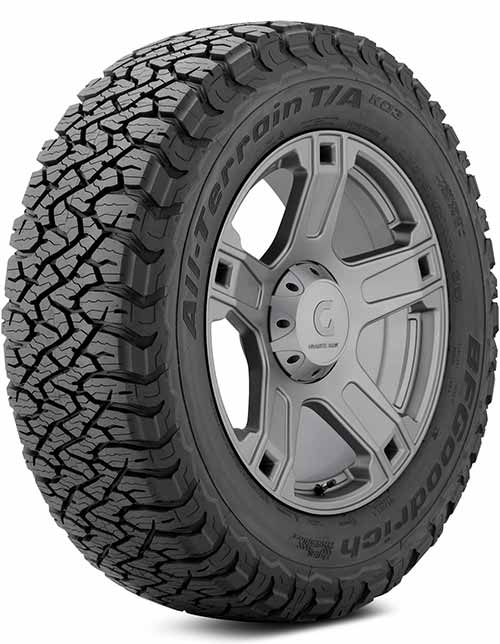There are several tire rotation patterns, but if you drive a rear wheel drive (RWD) or all wheel drive (AWD) car or truck, the rearward cross tire rotation pattern is usually the best pattern to use.
This pattern is designed specifically to improve tire wear for rear wheel and all wheel driven cars and trucks. It helps best address the aggressive wear on the rear axle tires and will evenly distribute wear to each tire over time.
Rearward Cross Tire Rotation
The rearward cross tire rotation pattern is designed for rear wheel drive vehicles. The front tires move rearward and across to the opposite sides of the vehicle. The rear tires move to the front but stay on the same sides of the car or truck.
Let’s dive into exactly what this pattern of tire rotation is and unique situations where you may not be able to use it.
Rearward Cross Tire Rotation Pattern
The rearward cross rotation pattern is best used with rear wheel drive and all wheel drive cars and trucks. It rotates the front tires rearward and across the vehicle. The rear tires move to the front but remain on the same sides.
5-Tire Rearward Cross Tire Rotation Pattern
The 5-tire rearward cross is a modification of the standard rearward cross that includes the spare tire into the rotation pattern. Obviously not for use with a temporary spare, but for those with a full size spare tire and wheel that matches the other four wheels.
The difference in this pattern is that one of the front tires will move to the spare tire position and the spare tire will be put into service at the rear tire position the front tire would have moved.
If you happen to drive a vehicle with a full size matching spare tire you can rotate tires with the spare tire included.
This modification of the rearward cross has great benefits for those that can take advantage of it:
- By including the spare tire when rotating your tires you will increase the life of your set of tires by 25%
- Your spare tire will get put to good use before needing to be replaced due to dry rot
- Your spare will be regularly checked for proper air pressure and inspected for damage which will help ensure it’s in good condition if you have an emergency situation where you need to use it
Why Is The Rearward Cross Best For Rear Wheel Drive?
The rearward cross pattern is optimized for use on rear wheel and all wheel drive vehicles. It takes the tire most likely to have the least wear, the passenger front, and moves it to the position most likely to have the most wear, the driver’s rear.
This is also a great pattern because it will ensure that each tire will eventually move to all for positions around the vehicle. This will maximize the benefit of rotating tires and help them wear more evenly.
The alternative pattern for rear wheel drive and all wheel drive vehicles is the X-pattern. While this is an acceptable pattern to use, it only swaps the tires between two positions. The tires will not eventually move to each tire position which is a little less than ideal.
When Should The Rearward Cross Not Be Used?
The rearward cross is best for rear wheel and all wheel drive vehicles. It shouldn’t be used if your rear wheel or all wheel drive car has directional tires or staggered wheels.
Directional Tires

Directional tires are a common limiting factor for tire rotation. Directional tires have many benefits, but a compromise for these benefits is the inability to swap a directional tire from one side to the other.
Once a directional tire has been mounted on a wheel, it will only be able to be used on one side of your car or truck. If you need to move it to the other side for some reason, you will need to remove the tire from the wheel and flip it around so the markings on the sidewall indicate that the tire will spin in the proper direction.
Staggered Wheels

Staggered wheels are those that are different sizes on the front and rear axles. Often, staggered wheels are wider in the rear to help improve traction and stability for rear wheel drive cars and trucks.
Obviously, when wider wheels are used in the rear, you don’t want to try to move the wider wheels to the front axle and the skinnier wheels on the rear where the wider contact patch was designed to provide better performance characteristics.
Why Do You Cross Tires When Rotating?
Moving tires from front to rear has the most benefit, but rotating from side to side also has benefits. Combining these helps maximize the benefit of rotating tires.
This is especially true of patterns like the rearward cross that ensure that each tire moves to every position around the vehicle.
Suspension geometry differences between front and rear axles has the greatest differences and the most benefit for evening out tire wear.
Even though the suspension geometries between the left and right sides technically should be the same, there are always some differences in the real world. Driving style and conditions can also have an affect on how tires wear side to side.
Rearward Cross Or X-Pattern
While the rearward cross and X-pattern can both be used for all wheel drive and rear wheel drive vehicles, the rearward cross is preferred.
The rearward cross has the additional benefit of ensuring that each tire will eventually be rotated to every position around the vehicle. The X-pattern only swaps each tire between the same two tire positions and therefore will not produce quite as even wear as the rearward cross will over time.
Final Thoughts
The rearward cross will do the best job of ensuring that the tires on your all wheel or rear wheel drive vehicle wear evenly. It does this by rotating each tire to every position around your car or truck and moving the tire that has recently received the least wear to the position that receives the most wear.
Tire rotation patterns can seem complex, but the bottom line is that rotating your tires in almost any pattern is better than not rotating them at all.
Resources
Below are some links you may find helpful when learning about tires





